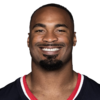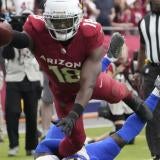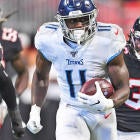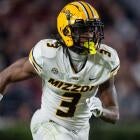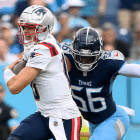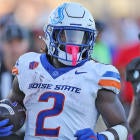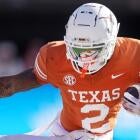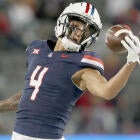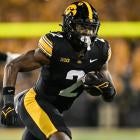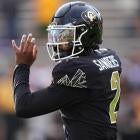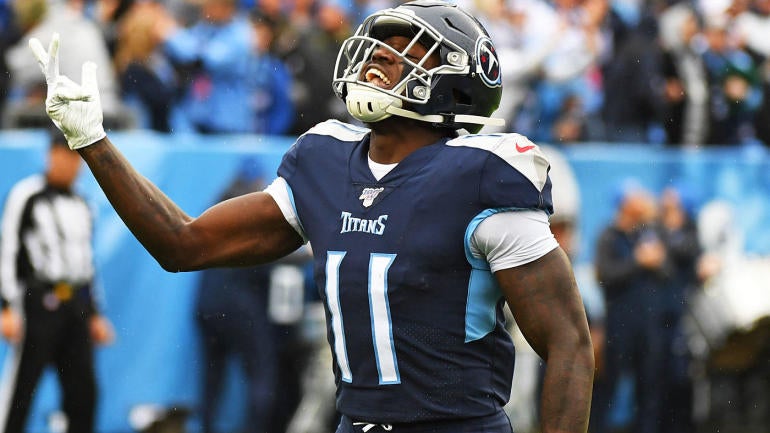
Regression isn't the most popular word to a lot of Fantasy Football players. It makes sense. When we talk about regression, we're often saying that the best performers from the previous season won't repeat their feats. However, it also means some players who were disappointing are probably going to be better.
It would be much easier if we could just take one season's stats and apply them to the next year, but without accounting for regression, you might have faded Kenny Golladay due to his low touchdown rate and missed out on his monster 2019.
I've done regression alert columns for years, and this year's will be a four-part series, with a separate articles for each position. That's because 2019 had a lot of outlier performances. When I set out to compile a list of regression candidates, I came up with more than 40 names across the four main Fantasy positions. Yes, some of 2019's best were there, including Lamar Jackson, Aaron Jones, Chris Godwin and Mark Andrews. But there were plenty of middling players as well.
Here are the biggest regression candidates at wide receiver:
In the second half of 2019, A.J. Brown was phenomenal. In the final six regular season games he caught 25 passes for 605 yards and five touchdowns despite averaging just 6.5 targets per game. Unfortunately, the playoffs showed just how unsustainable that production is on a team that runs as often as the Titans. In Tennessee's three playoff games, Brown caught five of 10 targets for 64 yards and no scores. While it's true Tennessee barely threw in the playoffs, it's also true that Corey Davis saw more targets than Brown, who only saw 15% of the team's attempts.
Touchdown rate is talked about a lot more with quarterbacks than receivers, but Brown's was 9.5% last year. That's about 80% better than league average. But maybe you think Brown is a star. Six receivers have caught at least 100 touchdown passes since 1992. Randy Moss (8.9%) is the only star receiver with a touchdown rate over 8.2%. The median for the group is 7%. Doing the math, if Brown has a 7% touchdown rate next year, he'd need 115 targets to match his eight scores from 2019.
Of course, Brown wasn't just elite at scoring touchdowns. He also averaged an absurd 12.5 yards per target. Tyler Lockett and Tyreek Hill are tied for the all-time lead at 9.44 yards per target. If you project Brown at 9.94, which hardly seems fair, he'd need 106 targets to reach the 1,051 yards he had in 2019.
Brown had 84 targets last year. If you only use Weeks 12-17, he was on pace for 104. The Titans still have Mike Vrabel, Arthur Smith and Derrick Henry. Unless things go bad for the Titans, it's hard to envision Brown seeing a significant spike above 120 targets, which means he'll need to be one of the best receivers of all time to improve on last year's production.
Kenny Golladay's yards per target (10.3) wasn't quite as outlandish as Brown's, but his touchdown rate (9.4%) was right there. While he's always been an elite YPT guy, Golladay only had eight touchdowns on 167 career targets before last year. He also shares the field with another regression candidate, Marvin Jones, who has consistently produced an above-average touchdown rate.
The one edge Golladay has on Brown is that his team throws the ball more often, and we've already seen him top 115 targets multiple times. Before Matthew Stafford went down in 2019, Golladay was on pace for 126 targets. If Golladay gets 125 targets, he's going to be a top-10 receiver in non-PPR. But a career 57.6% catch rate could keep his catch total low enough that he doesn't crack the top 12 in PPR. That's why Golladay has such a big discrepancy in his ranking depending on format.
Stefon Diggs has been a hard player to figure out. He's been used as both a short-area target and a downfield guy, and he's been really good at both. But now he's changing teams, which can be red flag, and he'll have a less accurate quarterback in Josh Allen. Even without the changes, there was no way he was repeating last year's 12.0 yards per target.
For his career, Diggs has averaged 8.7 YPT, which is very good, but a far cry from 2019. He's also averaged about 7.9 targets per game the past three years, though he's never actually played 16 games in a season. I can get on board with giving Diggs the 125 targets he projects for but I have dinged him a little in efficiency due to the downgrade at quarterback. That makes him a low-end No. 2 receiver for a 16-game projection. It's just hard to feel comfortable projecting him to do something he's never done.
Remember when Tyrell Williams scored a touchdown in five straight games to start the season? That's probably not going to happen again. Williams has always been efficient, but he's not matching last year's 9.3% touchdown rate or 10.2 YPT. And even if he did, I'm not sure he'd get enough to targets for us to care.
Williams figures to be behind Darren Waller for sure and quite possibly Henry Ruggs and Hunter Renfrow as well for targets in Oakland. And he already saw his role diminish in the second half of 2019 as Renfrow emerged. After Week 8, Williams had just one game with more than five targets. He should not be drafted in a standard league.
Darius Slayton had a very impressive rookie year. But his touchdown rate (9.5%) was the same as Brown's and he was not near as good as a prospect. There are simply too many mouths to feed in New York with Sterling Shepard, Golden Tate, Evan Engram and Saquon Barkley all out-targeting Slayton when they were available. Slayton is a fine best ball target, but unless the Giants battle injuries again he's likely to end up on the waiver wire in a standard league.
Honorable Mention
- Breshad Perriman had five touchdowns in his first three seasons. He scored five touchdowns in the final four games of 2019. Don't expect him to continue that breakout with the Jets.
- Golden Tate's career touchdown rate is a pedestrian 4.4%. Last year he scored on 7.1% of his targets. None of the Giants receivers should be drafted in the single-digit rounds.
- Devante Parker had nine career touchdowns entering 2019, then scored that many in his breakout fifth season. Between touchdown regression and the return of Preston Williams, you shouldn't bet on Parker as more than a No. 3 receiver.
- No, Marvin Jones won't repeat his 9.9% touchdown rate. But his 7.4% rate in Detroit is already elite, so he remains a value in the middle rounds of drafts as a No. 3 receiver.
It's Not All Bad
I shouldn't make this a different section, but I'm tired of fighting about it. Positive regression and negative regression are the same thing: regression. If a player's efficiency improves towards league average or his career norms, that is regression. And it should happen for these guys in 2020.
Odell Beckham had a 7.1% touchdown rate going into last year. In 2019, his rate was 3.0%. I think we'd all look at Beckham a little different if he'd scored eight touchdowns instead of four. He has a ton of upside as a No. 2 receiver if Kevin Stefanski calls enough pass plays.
Robert Woods has never been a big touchdown guy, but his 1.4% touchdown rate last year is just ridiculous. He's led the Rams in targets each of the past two seasons and barring injury should be viewed as a lock to finish in the top 20 PPR receivers.
Honorable Mention
- Anthony Miller would have made this list a year ago because he caught seven touchdowns on just 54 targets. Last year he saw 85 targets and scored just twice. With Taylor Gabriel gone, there's a legitimate chance Miller tops 100 targets, which should lead to a jump in scores.
- Russell Gage took over the Mohamed Sanu role in Atlanta, but no one noticed because of his 1% touchdown rate. From Week 8 on, Gage was on pace for 80 catches on 117 targets. A little better efficiency and he could be a viable No. 3 receiver in PPR.
It's Complicated
Coming regression can be mitigated by a variety of factors, both good and bad. Or regression can happen to two different numbers that cause a net neutral result. It's kind of frustrating to parse, but it's worth talking about. Here are some quick hitters on the complicated cases.
- There's no way Chris Godwin is repeating his 11.0 YPT or 7.4% touchdown rate. But he also finished as the No. 3 receiver in PPR scoring despite playing just 14 games. You could regress Godwin's efficiency 20% and he still projects as a top-five receiver and second-round pick.
- Marquise Brown's 9.9% touchdown rate is unsustainable, but he was never really healthy last year and should see a significant boost from his 71 targets. He's an excellent upside No. 3 receiver.
- Mike Williams is going to regress from 11.1 YPT, but his 2.2% touchdown rate could improve enough to make up for it. The bigger issue will be adjusting to Tyrod Taylor and finding some way to earn more targets with Keenan Allen, Austin Ekeler and Hunter Henry all in the way.
- Brandin Cooks and Christian Kirk both had a 2.8% touchdown rate, which should signal regression. But Kirk has to battle DeAndre Hopkins, Larry Fitzgerald and Kenyan Drake for targets while Cooks has to avoid another concussion.
- The only thing that kept D.J. Moore from being truly elite last year was a 3.0% touchdown rate. Normally that would signal regression, but he only had a 2.4% rate as a rookie. We're one year away from accepting Moore as a low touchdown guy. Speaking of which ...
- TY Hilton has never scored more than seven touchdowns in a season and hasn't topped six since 2014. So his 7.4% rate is going to fall from last year. But good health and Philip Rivers could help Hilton bounce back to be a top-20 receiver anyway.
So what Fantasy football sleepers should you snatch in your draft? And which WR1 candidate can you wait on until late? Visit SportsLine now to get cheat sheets from the model that was all over Derrick Henry's huge season, and find out.
![[object Object] Logo](https://sportshub.cbsistatic.com/i/2020/04/22/e9ceb731-8b3f-4c60-98fe-090ab66a2997/screen-shot-2020-04-22-at-11-04-56-am.png)













